A single day Spring Tour today in North Norfolk. It was cloudy all day but thankfully stayed dry. A blustery and cold north wind would make like slightly difficult for us, keeping some birds down, but adverse weather can also lead to new birds dropping in, as we would find out.
Our first destination for the morning was Holkham. As we drove up along Lady Anne’s Drive, we noticed two pairs of Grey Partridge feeding quietly on the edge of the grazing meadows by the side of the road. A nice start to the day.
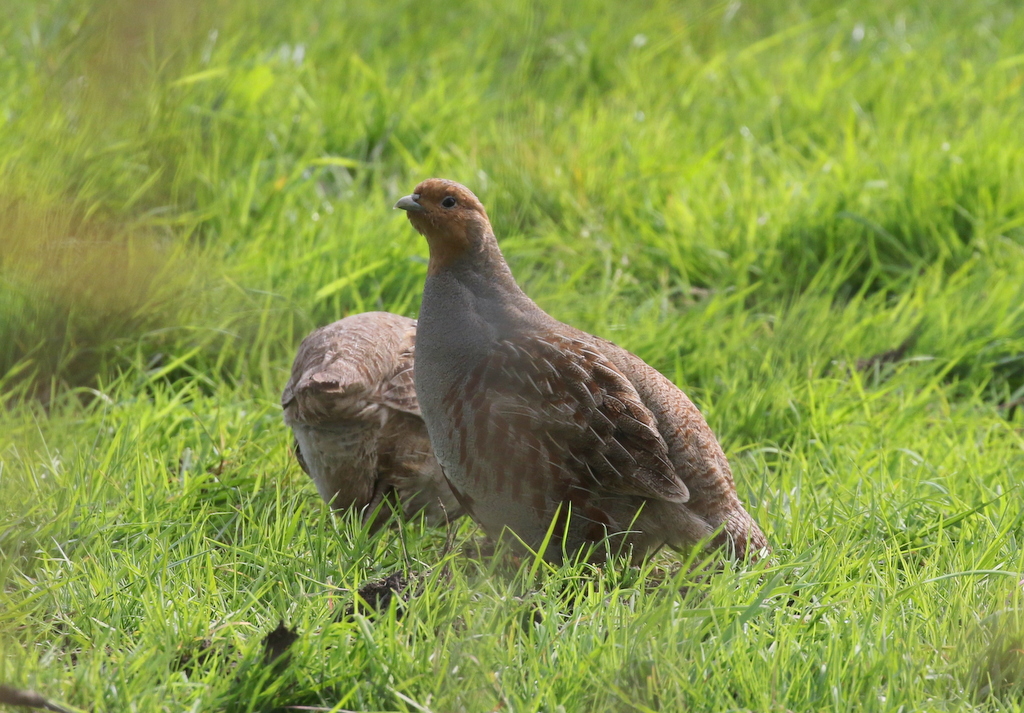
A little further on, we pulled up and got out to scan the rushy pools on the grazing marsh. A pair of Avocet were feeding down at the front, but a pale wader half hidden out at the back caught our eye. Through the rushes we could see it was a Greenshank, a spring migrant stopping off here on its way north. Perhaps a sign of things to come today? There was also no shortage of Greylag Geese and a few Shelduck out on the marshes.
Parking at the north end, we took the track west on the inland side of the pines, which gave us a bit of shelter from the cold wind this morning. Still, it was rather subdued in the trees today, although we did hear a few warblers singing – a few Blackcap, one or two Chiffchaff, and the sweet descending scale of a Willow Warbler.
There were no birds on Salts Hole this morning – it seems to be more popular as a swimming pool for dogs at this time of year! In the reeds just beyond we heard a Sedge Warbler singing and a little further on there were several Reed Warblers too, but they were all keeping well tucked down out of the wind today.
A male Marsh Harrier was patrolling the marshes and flew off carrying a small rodent which it had caught. There were lots of Common Swifts zooming back and forth low over the marshes today too, trying to find insects in the wind. We headed for Joe Jordan Hide.
When we got to the hide, one of the wardens was driving around out on the marshes, surveying, so there was not much to see at first. Thankfully, after a short while, he flushed a Great White Egret and after flying around various pools and ditches for a while it landed out in the grassy pools in front of the hide.
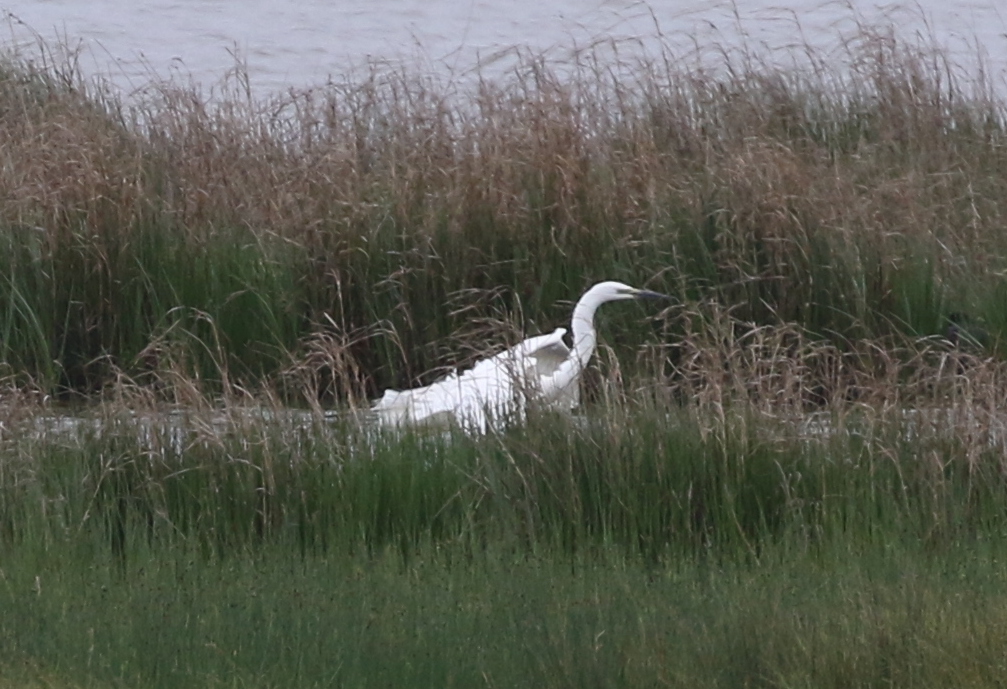
This Great White Egret was sporting an all dark bill, which they can do in the breeding season. A second Great White Egret which flew out of the trees still had an all yellow bill. It landed out of view in a ditch behind some bushes. There were a few Little Egrets flying in and out of the trees too, but numbers still appear to be down on previous years, after the cold March weather took its toll.
The Spoonbills are the chief draw here, but they were rather elusive at first. We saw a couple circle up out of the trees and drop back in again, and the warden helpfully flushed one from behind the trees along with a great gaggle of Greylags and mass of Woodpigeons, which did a nice fly round. We could just see the heads of a pair of Spoonbills in the vegetation behind the fort.
Eventually one Spoonbill did the decent thing and flew down to the pool. It did land behind the reeds at first, but then walked out and started to bathe and preen, so that we could get a good look at its yellow-tipped spoon-shaped bill. Its shaggy nuchal crest was blowing around in the wind.
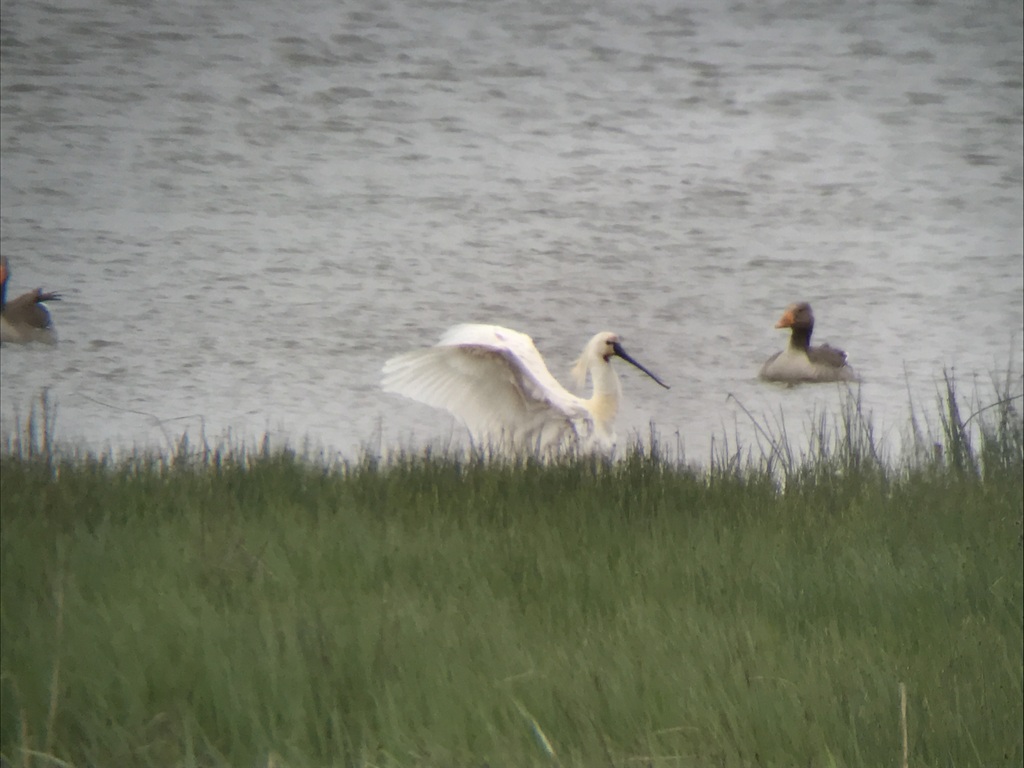
There were a few Cormorants coming and going to and from the trees too. We watched a Marsh Harrier drop into a small clump of reeds, clearly after something it had seen. It wrestled its way into the thick vegetation and eventually emerged with what looked like a young Moorhen.
There are plenty of Greylag Geese out on the marshes here, many with small goslings now. One goose in the corner of the pool stood out – smaller, with a dark head and smaller mostly dark bill, the latter very different from the big orange carrots sported by the Greylags. It was a lone Pink-footed Goose, and we had a good look at it through the scope side by side with one of its larger cousins. Almost all the Pink-footed Geese which spent the winter here have gone north to Iceland to breed, but just a handful of sick or injured birds will remain through the summer.
Back to the car, we headed east along the coast road to Cley, with the prospect of some shelter in the hides and hoping for some waders out on the reserve. Our first stop was down at the beach. There were no terns fishing offshore today in the wind – a single Sandwich Tern took the alternative route back to the Point today , inland across the Eye Field. We decided on a bracing walk along the beach towards North Scrape.
Our braveness quickly paid off, with a smart male Wheatear sheltering amongst the concrete blocks out on the shingle. We had a great look at it, just a few metres in front of us, before it flew off, flashing the white rump from which it gets its name.
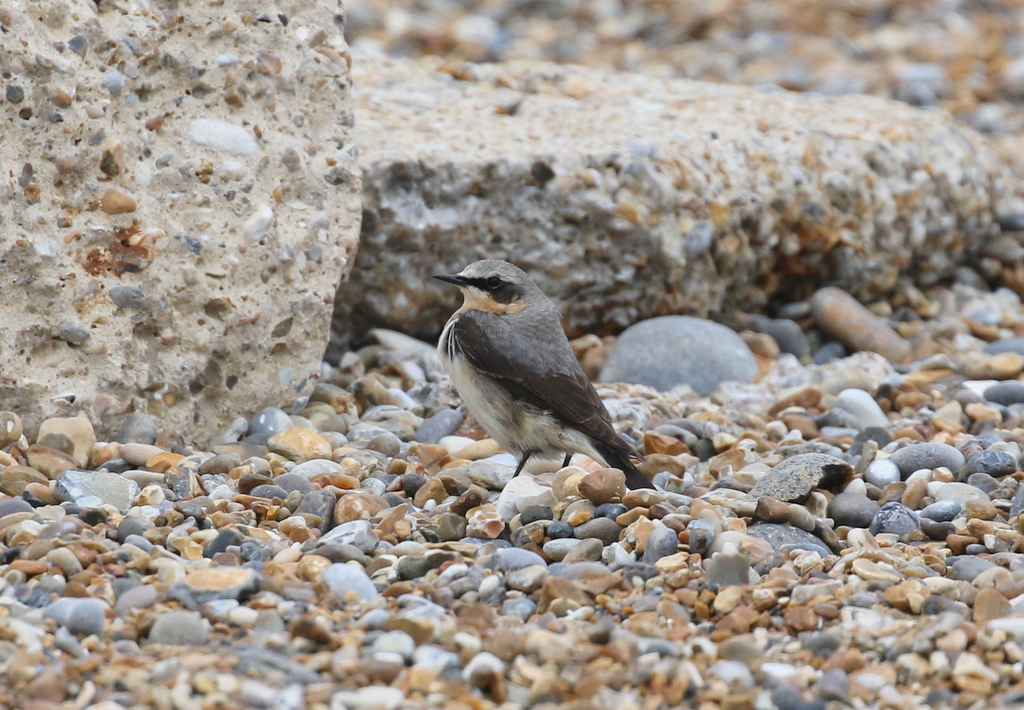
From the ridge on the edge of the Eye Field, we stopped to scan Billy’s Wash and North Scrape, but both looked to be pretty quiet today. Given the wind, we decided not to continue on further and headed back to the car park where we made good use of the beach shelter to have our lunch. Afterwards, we drove round to the visitor centre to get our permits for the reserve and as we came out, a Yellow Wagtail flew over our heads calling and dropped down towards the scrapes.
There were lots more Common Swifts hanging in the air low over the Visitor Centre and they zoomed round low over our heads as we walked out to the hides, before drifting off and gathering over the trees behind the village. A couple of Reed Warblers were singing from the reeds along the ditch, but kept their heads down out of the wind.
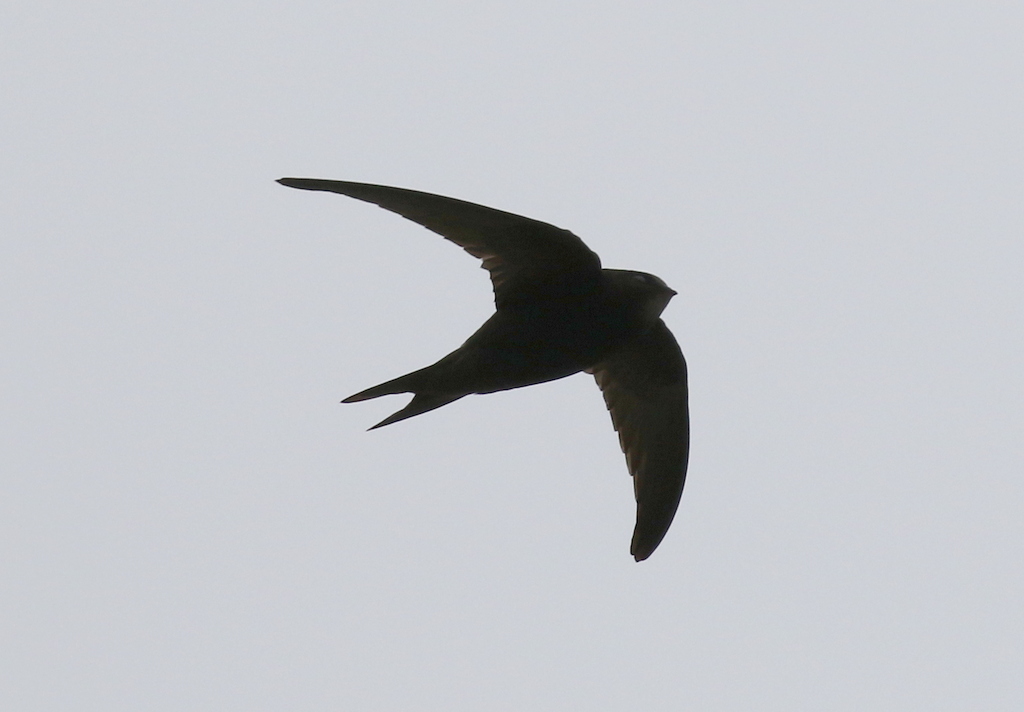
We popped into Avocet Hide first, to see if there was anything on Whitwell Scrape. A pair of Gadwall were feeding just below the hide as we opened the flaps and a lone drake Teal was swimming on the edge of the reeds right at the back. A couple of Sandwich Terns were hiding in with the Black-headed Gulls before flying off calling.
We could see a couple of Avocets hunkered down on the nest on the first island. A third Avocet flew in and stopped to preen in the water briefly before walking up to one of the nests and replacing its partner, taking its turn at incubating the eggs.

There was clearly much more to be seen on Simmond’s Scrape, so we made our way round to Dauke’s Hide for a closer look. There were lots of Black-tailed Godwits on here, busy feeding, probing their long bills down into the mud in the deeper water. About twenty Dunlin were scattered around the edges of the muddy islands, most sporting summer black belly patches to a greater or lesser extent, along with a single Ringed Plover.
Then a small wader on a spit over in the far corner caught our eye. Obviously smaller than the Dunlin the other side, through the scope we could see it was mostly brown with scattered black-centred feathers in its upperparts, clean white below and with yellowish legs. It was a Temminck’s Stint, a scarce migrant wader which passed through in small numbers each spring. A nice bird to find here.
Thankfully just after everyone had a chance to look at it through the scope, everything on the scrape erupted, flushed by a passing Marsh Harrier over the reeds beyond. The Black-tailed Godwits settled back on Pat’s Pool but the Temminck’s Stint and the Dunlin all seemed to disappear off over the reserve.
Turning our attention to Pat’s Pool, a couple of Ruff were hiding in with the godwits now, including a smart black male which was starting to get its distinctive summer ruff. Out on the mud, we spotted a Greenshank, which then helpfully walked up beside a Common Redshank to give us a nice side by side comparison.

More waders were clearly dropping in, probably encouraged to stop off on their journey north by the cold and windy weather. When we next looked back where the Greenshank was feeding, it had been replaced by a Wood Sandpiper. Much smaller than the accompanying Redshanks, through the scope we could see its white-spangled upperparts and prominent pale supercilium. Another scarce spring migrant wader, and another nice one to add to the day’s list.

The Dunlin returned to Simmond’s Scrape after a while and then someone found the Temminck’s Stint back again, asleep on one of the islands. There were two Little Terns out here now too – through the scope, we could see their black-tipped yellow bills and white foreheads.
When the Temminck’s Stint woke up, it had a quick preen, and then helpfully flew round and landed on the island in front of the hide where we could get a really good look at it. We had seen a Temminck’s Stint here on Saturday, but this was clearly now a new bird, not quite as extensively marked with dark-centred feathering as the bird the other day.
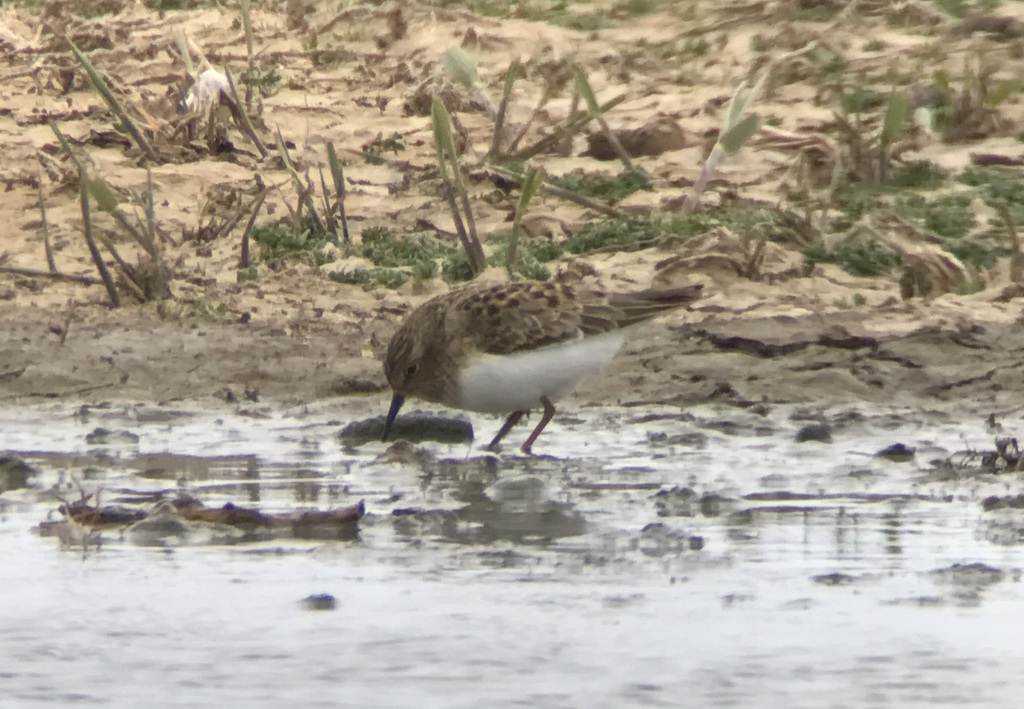
Very pleased with what we had seen here today, we made our way back to the Visitor Centre and drove round to Iron Road next. There was very little to be seen on the pool by the track, so we walked out to Babcock Hide to have a look at Watling Water. We had not even got to the hide when we spotted the five Spoonbills which had been wandering round the reserve today. Unfortunately, where they were standing was completely hidden from view from the hide, behind the reeds!
There were a few other birds to look at one here. A Common Sandpiper was feeding up and down along the edge of one of the islands, before it flew over back over the reeds. Two Little Ringed Plovers were sheltering on the other side of the island, in the lee of the wind. Through the scope, we could see their distinctive golden yellow eye rings.
The Spoonbills eventually emerged from where they were hiding and flew over to the back of the pool, where they started to feed, their heads down in the water, sweeping their bills quickly from side to side.
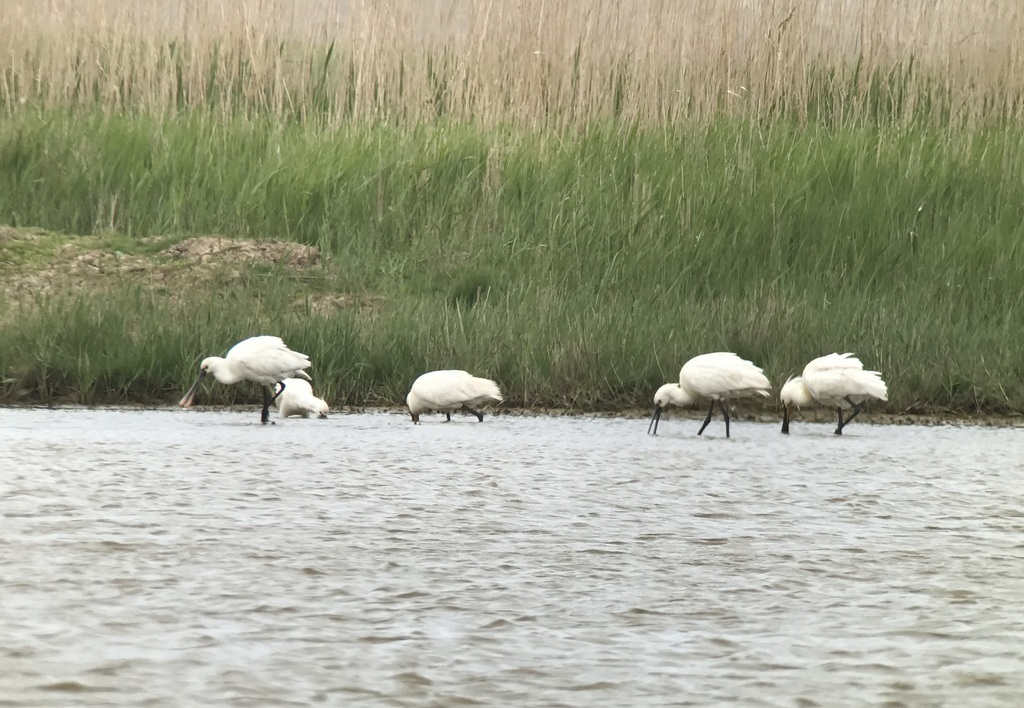
There was still a little bit of time left, so we decided to brave the wind and walk up along the East Bank. Thankfully, it had dropped a bit but it was still rather chilly and blustery. A Reed Warbler was singing in the reeds just the other side of the channel below the bank and we had a quick look at it through the scope before it dropped down out of view.
There did not appear to be much out on the Serpentine or Pope’s Pool today, but we did find a single lingering drake Wigeon, a useful addition to the day’s list. Almost all the Wigeon which spent the winter here have long since departed, back to Russia for the breeding season. Arnold’s Marsh was also fairly quiet today, with a few Redshank and Ringed Plover, and a single Turnstone hiding in the vegetation along the edge.
It was time to head back now, but it had been a very productive day despite the wind, with a great selection of spring waders in particular.
















